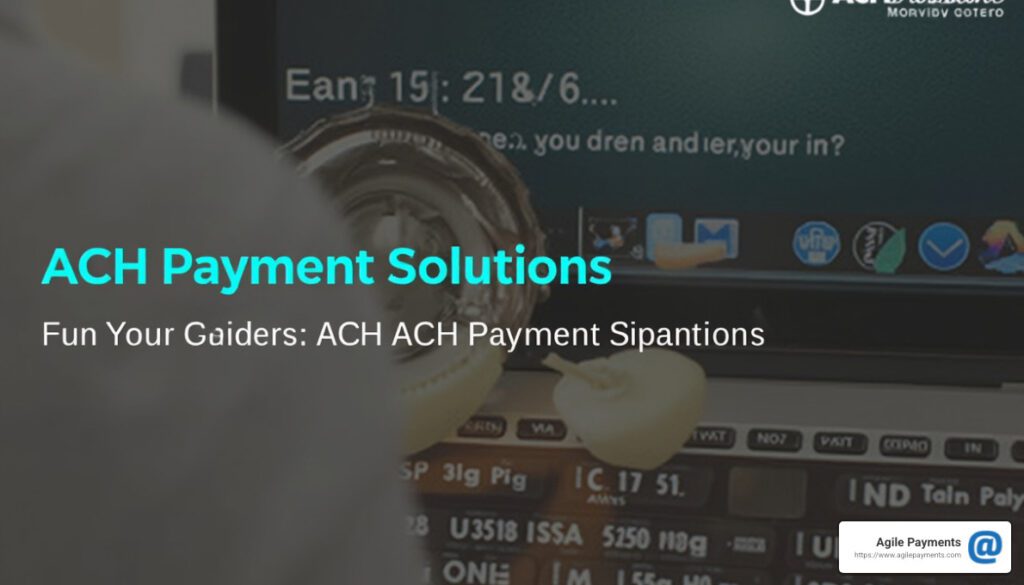Bank Account Verification Process: Top 5 Essential Steps
The bank account verification process is a key step for businesses in validating the authenticity of their financial transactions. It confirms the legitimacy and ownership of a customer’s bank account. Here’s a quick overview:
- What it is: A method to confirm a customer’s identity and account ownership.
- Why it matters: It helps prevent fraud, ensures regulatory compliance, and builds customer trust.
- Methods used: Methods include document-based checks, micro-deposits, and leveraging open banking technologies.
Every financial transaction has potential risks, and without proper verification, businesses can fall prey to fraud. By confirming account details and following compliance standards like KYC (Know Your Customer) and AML (Anti-Money Laundering), companies not only protect themselves but also foster trust with their customers.
At Agile Payments, we understand the pivotal role of the bank account verification process. My name is Gene Krause, and with over 25 years dedicated to payment integrations, I’ve seen how crucial seamless and secure verification is for businesses in the U.S. and Canada. Follow along as we dig deeper into this essential process.

What is Bank Account Verification?
Bank account verification is a process that confirms a bank account’s validity and ownership. It plays a vital role in ensuring that the account truly belongs to the person claiming it. This isn’t just about checking numbers; it’s about building trust and security in financial transactions.
Identity Confirmation
At its core, bank account verification is about confirming the identity of the account holder. This is crucial for businesses to ensure they are dealing with real customers. By verifying identities, companies can avoid fraudulent transactions and protect both themselves and their customers.
Account Ownership
Confirming account ownership is another key aspect. It’s not enough to know that an account exists; businesses need to ensure that the person claiming ownership is indeed the rightful owner. This step is vital in preventing identity theft and unauthorized access to funds.
KYC and AML Compliance
Bank account verification is also integral to compliance with KYC (Know Your Customer) and AML (Anti-Money Laundering) regulations. These regulations require businesses to verify the identities of their customers and monitor their transactions to prevent illegal activities like money laundering. By adhering to these standards, companies not only comply with the law but also improve their reputation for reliability and security.

In summary, bank account verification is not just a technical step; it’s a comprehensive process that safeguards financial transactions. By focusing on identity confirmation, account ownership, and compliance with KYC and AML regulations, businesses can effectively combat fraud and build stronger relationships with their customers.
Coming up, we’ll explore the detailed steps involved in the bank account verification process, including various methods like document-based verification and micro-deposits.
The Bank Account Verification Process
The bank account verification process is essential for confirming the legitimacy and ownership of a bank account. This section will guide you through the different methods used to verify bank accounts, ensuring both security and compliance.
Document-Based Verification
Document-based verification is one of the traditional methods used in the verification process. It involves checking documents like government-issued IDs, utility bills, or bank statements against the account details provided by the user. This method is thorough but can be time-consuming and prone to errors if documents are forged or outdated.
Micro-Deposits
Micro-deposits are a popular and less invasive method for verifying bank accounts. Here’s how it works:
- The financial institution sends a small amount, such as $0.15, to the user’s bank account.
- The user then checks their account and confirms the exact deposit amount.
- This confirmation helps verify the account’s validity and ownership.
Micro-deposits are widely used by investment platforms, payment services like PayPal, and P2P apps because they comply with KYC/AML requirements and are familiar to users.
Open Banking
Open banking is a modern approach that allows third-party services to access bank account information securely, with the user’s consent. This method provides real-time access to account data, enabling instant verification. Open banking is gaining popularity for its efficiency and ability to reduce manual errors, offering a seamless experience for users.
Credit Checks
Credit checks involve cross-referencing the account details with a credit bureau database. This method provides reliable information about the user’s financial background, such as credit accounts and payment records. By using AI-powered tools, companies can quickly verify accounts and maintain a smooth user experience. Credit checks are particularly useful for fraud prevention, as they offer a multi-layer approach to security.

Each of these methods plays a crucial role in the bank account verification process. By understanding and implementing these techniques, businesses can ensure secure and efficient transactions, protecting both themselves and their customers from fraud.
Next, we’ll dive into why bank account verification is so important in today’s digital landscape.
Why is Bank Account Verification Important?
Bank account verification is crucial for several reasons, each playing a vital role in today’s digital financial landscape.
Fraud Prevention
Fraud is a growing concern in the digital age. According to the Federal Trade Commission, there were 2.4 million reports of fraud in 2022, with losses totaling approximately $8.8 billion. The checking account verification process helps combat this by ensuring that only authorized individuals can access sensitive financial information. By confirming account ownership, businesses can prevent fraudsters from using stolen identities or creating fake accounts.
Regulatory Compliance
In many industries, especially financial services, regulatory compliance is not optional. Laws like Know Your Customer (KYC) and Anti-Money Laundering (AML) require businesses to verify the identities of their customers. Failure to comply can result in hefty fines and legal penalties. Bank account verification helps businesses meet these regulatory requirements by validating account holders and preventing illicit activities like money laundering.
Customer Trust
Trust is the foundation of any business relationship. Customers need to feel confident that their financial information is secure. By implementing robust bank account verification methods, businesses can build this trust. When customers know that their data is protected, they are more likely to engage in online transactions and continue using the service. This trust not only improves customer satisfaction but also strengthens the company’s reputation in the market.
In summary, bank account verification is more than just a procedural step. It’s a critical component for preventing fraud, ensuring regulatory compliance, and building customer trust. As digital transactions continue to grow, the importance of effective verification methods cannot be overstated.
Next, let’s explore the various methods of bank account verification and how they work.
Methods of Bank Account Verification
When it comes to verifying bank accounts, there are several methods available, each with its own pros and cons. Let’s explore the options:
Micro-Deposits
One of the most traditional methods is using micro-deposits. This involves the financial institution making two small deposits into the customer’s account, usually less than a dollar each. The account holder then checks their account, notes the exact deposit amounts, and reports them back to the institution.
Pros:
- Reliable and Secure: Since the account holder must verify the deposit amounts, it’s a strong indicator of account ownership.
- Cost-Effective: Generally low-cost for businesses to implement.
Cons:
- Time-Consuming: It can take 1-3 business days for the deposits to appear, which can delay the verification process.
Instant Verification
Instant verification offers a quicker solution. This method typically involves linking the user’s bank account directly to the service provider’s platform. By accessing the bank’s API, the service can instantly verify account ownership.
Pros:
- Speedy Process: Verification happens in real-time, reducing wait times for both businesses and customers.
- Seamless Integration: Can be easily incorporated into online workflows, enhancing the user experience.
Cons:
- Privacy Concerns: Users may be wary of granting access to their bank data, fearing exposure of sensitive information.
API Integration
With API integration, businesses can embed the bank account verification process directly into their systems. This method allows for automated checks and real-time updates, making it a popular choice for tech-savvy companies.
Pros:
- Automation: Reduces the need for manual checks and minimizes human error.
- Scalability: Easily scales with business growth, accommodating increasing verification needs.
Cons:
- Implementation Complexity: Requires development resources to set up and maintain the integration.
Document-Based Verification
This traditional approach involves customers submitting bank statements or certificates showing their account details. The business then manually reviews these documents to confirm ownership.
Pros:
- Trustworthy: Directly issued by the bank, offering a high level of credibility.
- Low Tech: Doesn’t require advanced technology to implement.
Cons:
- Manual Process: Involves significant time and effort to review documents.
- User Inconvenience: Requires customers to obtain and submit physical or digital documents, which can be a hassle.
Each method has its place depending on the business needs and customer preferences. Whether you’re looking for speed, security, or simplicity, there’s a method to suit your requirements.
Now that we’ve covered the various methods of bank account verification, let’s move on to explore the limitations and challenges these methods may present.
Limitations and Challenges
While the bank account verification process offers many benefits, it also comes with its own set of limitations and challenges. Let’s take a closer look at some of the key issues:
Security Risks
Security is always a top concern when dealing with financial information. Even with robust security protocols, there’s always a risk of data breaches or unauthorized access. For instance, instant verification methods require users to share bank login details, which can make some customers uncomfortable. It’s crucial for businesses to use strong encryption and adhere to industry security standards to protect sensitive data.
Human Error
Human error is another significant challenge, especially in document-based verification. Manual checks can lead to mistakes, such as misreading account numbers or overlooking discrepancies. This not only slows down the verification process but also increases the risk of fraud slipping through the cracks. Automation of verification procedures can help minimize these errors, but it’s not foolproof.
Outdated Information
Bank account details can change over time, such as when a customer switches banks or updates their account information. If the verification system relies on outdated data, it can lead to incorrect verifications. This is particularly problematic in document-based methods, where the submitted documents may not reflect the most current information. Regular updates and ongoing monitoring are essential to ensure the accuracy of verification data.
These challenges highlight the importance of choosing the right verification method and continuously improving the process to address potential pitfalls. As we explore the frequently asked questions about bank account verification, we’ll dig deeper into how these challenges can impact the overall process.
Frequently Asked Questions about Bank Account Verification
How is bank account verification done?
Bank account verification can be done using several methods, each with its own strengths and weaknesses. Here’s a quick rundown:
Document-Based Verification: This involves customers submitting documents like bank statements or voided checks. These documents are then checked for authenticity and accuracy to confirm account ownership. It’s a straightforward method but can be slow and prone to human error.
Micro-Deposits: This method involves sending small deposits to the customer’s bank account. The customer then confirms the exact amounts to verify their account. It’s a reliable way to confirm account ownership, but it can take a few days to complete.
Open Banking: By connecting directly to the customer’s bank account via an open banking provider, businesses can verify account details instantly. This method is quick and efficient but requires customers to share their bank login details.
Credit Checks: This involves checking the customer’s account details against information held by credit bureaus. If the information matches, the account is verified. It’s a fast method, but it may not always reflect the most current account status.
What is the verification process in banking?
The bank account verification process in banking involves several steps to confirm a customer’s identity and account ownership. Here’s how it typically works:
Know Your Customer (KYC): This is a legal requirement where banks collect and verify information about their customers. It helps prevent identity theft and financial fraud.
Anti-Money Laundering (AML): These are procedures and regulations designed to prevent money laundering activities. Banks use AML checks to ensure that their services are not being used for illegal activities.
Account Ownership Verification: This step confirms that the person using the bank account is the rightful owner. Methods like micro-deposits or document-based verification can be used to establish ownership.
How long does it take to validate a bank account?
The time it takes to validate a bank account depends on the method used:
Document-Based Verification: This can take several days, as it involves manual checks and the submission of physical documents.
Micro-Deposits: Typically, this method takes a few days to complete, as it relies on the time it takes for deposits to appear in the customer’s account.
Open Banking and Credit Checks: These methods offer instant verification, providing results in a matter of seconds. They’re efficient but require the customer to share sensitive information.
Understanding these different methods and their timelines can help businesses choose the right approach for their needs.
Conclusion
Ensuring secure transactions is more important than ever. At Agile Payments, we understand the critical role of the bank account verification process in safeguarding financial transactions and building customer trust. Our solutions are designed to make this process as seamless and secure as possible.
We offer developer-friendly APIs that allow businesses to integrate bank account verification into their systems with ease. Our APIs are agile and adaptable, catering to both U.S. and Canadian markets. This flexibility ensures that you can choose the verification method that best suits your business needs, whether it’s micro-deposits, open banking, or API integration.
Security is our top priority. We employ robust encryption protocols and adhere to the highest industry standards to protect sensitive customer data. This commitment to security not only helps prevent fraud but also ensures compliance with regulatory requirements like KYC and AML.
By choosing Agile Payments, you’re opting for a partner that values innovation and security. Our solutions are designed to help you stay ahead in the changing financial landscape, providing you with the tools needed to offer quick, precise, and secure transactions.
Ready to streamline your bank account verification process? Explore our bank account verification services and see how we can help you achieve secure and efficient transactions.





